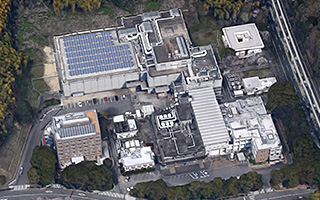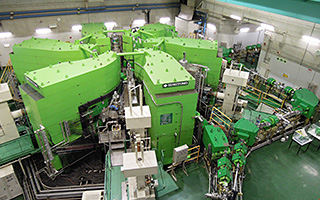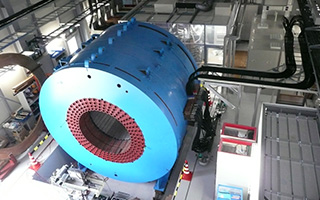Overview of RCNP
A Joint Usage/Research Center with an aim to promote international collaborations
on cutting-edge research in nuclear physics as well as applied sciences,
by making the most of the uniqueness in having the largest facility on a university campus.
Research Center for Nuclear Physics (RCNP) of Osaka University is a joint research center with the largest accelerator facility on a university campus in Japan. Besides the cyclotron facility, RCNP also operates the Laser-Electron Photon facility at SPring-8 and the double-beta decay laboratory in Kamioka, both located outside the university campus. RCNP offers unique opportunities for basic science research and education. As a Joint Usage/Research Center -- Research Center of Subatomic Sciences, we promote experimental and theoretical research in subatomic physics, especially nuclear physics, through international collaborations to elucidate the fundamental laws that govern the microscopic world of one quadrillionth of a meter. In addition, beams from the accelerators are also supplied for research in material science using secondarily-generated neutrons and muons, and for medical purpose through the radioisotope productions.
Two committees, the RCNP Steering Committee and the Physics Program Advisory Committee (P-PAC), are formed to advise on matters related to management and research plans of RCNP. Both committees are made up of elected members from RCNP as well as from among physicists outside of RCNP in nuclear physics and its related fields; the latters account for more than half of the members of committees. In addition, B-PAC and Q-PAC are organized under P-PAC to evaluate proposals for experiments at the Cyclotron and Laser-Electron Photon facilities, respectively.
As a facility that promotes accelerator-based research, we strive to ensure radiation safety of all users. All matters related to safety are undertaken by the Administration for Safety, Hygiene and Radiation Control Office.

Bird-eye view of RCNP

Ring-Cyclotron

LEPS2
Committees
History
History of
Nuclear Physics Research
at Osaka University
1931
Osaka Imperial University was founded. The first president was Hantaro Nagaoka (famous for Saturnian Model of the Atom)
1933
School of Science was founded. Hideki Yukawa got a post of lecturer.
Construction of a Cockcroft-Walton accelerator started (Masashi Kikuchi).
1935
Dr. Hideki Yukawa published the first paper on the meson theory.
Construction of a cyclotron started (Masashi Kikuchi).
1937
Construction of a cyclotron completed.
1940
Construction of a van de Graaff accelerator started (Tetsuo Wakatsuki and Koji Fushimi).
1955
Laboratory of Nuclear Studies has been founded under school of science.
History of
Research Center
for Nuclear Physics
1962
Science Council of Japan exhorted the government to found a laboratory of nuclear physics.
1971
Research Center for Nuclear Physics was founded as a collaboration research center of the nuclear physics community. The first director was Shotaro Yamabe.
1973
Construction of the AVF cyclotron completed.
1976
Collaboration research experiments started.
1985
Cyclotron cascade project was planned.
1987
Construction of the RING cyclotron started.
1991
Construction of the RING cyclotron completed.
1997
Oto Cosmo Observatory was constructed.
2000
Laser Electron Photon beam line at SPring-8 (LEPS) was constructed.
2005
Upgrade of the injector cyclotron completed.
2007
Cosmo-nuclear Physics Division was inaugurated.(-2012)
2009
Kamioka Double-beta Decay Laboratory was constructed.
2010
RCNP was authorized as a Joint Usage/Research Center “Research Center of Subatomic Sciences”.
2011
Laboratory of Nuclear Studies in Graduate School of Science was integrated into RCNP
2013
Laser Electron Photon beamline II at SPring-8 (LEPS2) was constructed.


